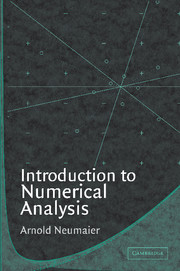1 - The Numerical Evaluation of Expressions
Published online by Cambridge University Press: 20 May 2010
Summary
In this chapter, we introduce the reader on a very elementary level to some basic considerations in numerical analysis. We look at the evaluation of arithmetic expressions and their derivatives, and show some simple ways to save on the number of operations and storage locations needed to do computations.
We demonstrate how finite precision arithmetic differs from computation with ideal real numbers, and give some ideas about how to recognize pitfalls in numerical computations and how to avoid the associated numerical instability. We look at the influence of data errors on the results of a computation, and how to quantify this influence using the concept of a condition number. Finally we show how, using interval arithmetic, it is possible to obtain mathematically correct results and error estimates although computations are done with limited precision only.
We present some simple algorithms in a pseudo-MATLAB® formulation very close to the numerical MATrix LABoratory language MATLAB (and some – those printed in typewriter font – in true MATLAB) to facilitate getting used to this excellent platform for experimenting with numerical algorithms. MATLAB is very easy to learn once you get the idea of it, and the online help is usually sufficient to expand your knowledge. We explain many MATLAB conventions on their first use (see also the index); for unexplained MATLAB features you may try the online help facility. Type help at the MATLAB prompt to find a list of available directories with MATLAB functions; add the directory name after help to get information about the available functions, or type the function name (without the ending .m) after help to get information about the use of a particular function.
- Type
- Chapter
- Information
- Introduction to Numerical Analysis , pp. 1 - 60Publisher: Cambridge University PressPrint publication year: 2001



